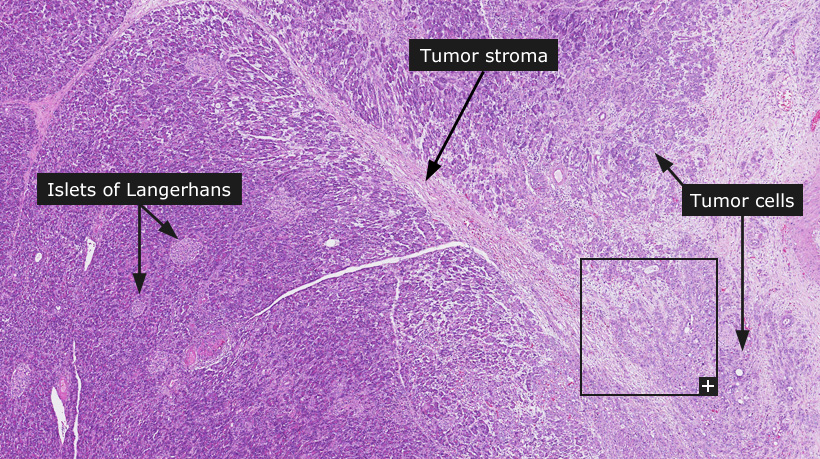DictionaryPancreatic cancerPancreatic cancerMale, 62 years, poorly differentiated adenocarcinoma 
Pancreatic cancerPancreatic cancer is a relatively common form of human cancer and is associated with a poor prognosis. The risk of pancreatic cancer increases with age and the tumor is slightly more common in women than in men. Pancreatic cancer is often detected at such a late stage of the disease that curative surgery is not possible. The spread of pancreatic cancer at time for diagnosis is a major reason for the dismal prognosis, rendering pancreatic cancer a leading cause of cancer death. Signs and symptoms are diffuse and do usually not become apparent before the cancer has reached an advanced stage. Most patients are above 50 years of age and pain, jaundice and weight loss are the most common symptoms. The cause of pancreatic cancer is unknown. However, pancreatic cancer is more common in persons with diabetes and chronic pancreatitis (persistent inflammation in the pancreas) as well as in tobacco smokers. Most cancers of the pancreas are ductal adenocarcinomas, with two-thirds of tumors arising in the head of the pancreas. Ductal carcinomas grow rapidly and have often spread beyond the pancreas at time of diagnosis. Ductal carcinomas are poorly demarcated tumors that are characterized by atypical cells forming irregular, often complex and incomplete, tubular or glandular structures, embedded in a dense desmoplastic tumor stroma. Ductal carcinoma is often accompanied by chronic pancreatitis showing infiltrates of inflammatory cells, fibrosis and atrophy of normal exocrine pancreatic structures. Tumor cells appear pleomorphic with variation in shape and size of tumor cell nuclei, often with conspicuous nucleoli. The rate of proliferation is often high and mitotic figures are easy to find. Necrotic cellular debris can often be found in the lumina of cancerous glands and ducts. Invasion into tiny vessels or into perineural lymphatics is a common feature. Ductal carcinomas are classified as well, moderately or poorly differentiated dependent on morphology. The degree of differentiation may vary within a tumor so that occasional anaplastic foci of tumor can be present within an otherwise well-differentiated ductal carcinoma. The differentiation grade has not proven helpful for predicting prognosis and likewise has staging only limited value as the vast majority of patients have an advanced stage of the disease when diagnosed. Aside from local spread in the pancreas and to surrounding tissues, pancreatic cancer often spreads to regional lymph nodes and to the liver. In addition to the typical ductal carcinoma there are uncommon variants of pancreatic cancer, including adenosquamous carcinoma, mucinous carcinoma, papillary carcinoma and acinar cell carcinoma. Moreover, mucinous cystadenocarcinoma and tumors corresponding to the endocrine compartment of the pancreas also exist with various symptoms, microscopical features and often less severe prognosis.
Normal tissue: Pancreas |